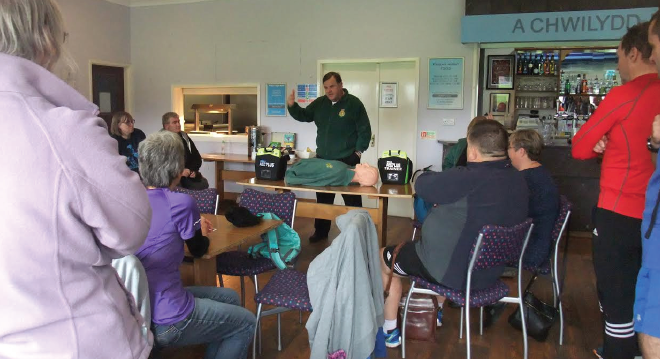
THE HERALD had the privilege of witnessing the presentation of the brand new defibrillator at Aberystwyth Rugby Club on Saturday (Oct 8).
The defibrillator, placed on the wall of the Rugby Club, was officially presented by representatives of the British Heart Foundation and members of Aberystwyth Parkrun to mark its arrival in Aberystwyth.
The essential piece of equipment was purchased through the British Heart Foundation and was kindly financially purchased by both Aberystwyth Parkrun and the Aberystwyth Rugby Club.
It will be displayed for public use and will be accessible to the emergency services at any given time as well as The Rugby Club, Aberystwyth Parkrun, Aberystwyth AC and members of the public in the Plascrug area.
The presentation coincided with the first defibrillator training session in the Aberystwyth Rugby Club, where two members of the Welsh Ambulance Service demonstrated how to use the defibrillator to members of Aberystwyth Parkrun and the public who were present.
Rowland Jones, from the British Heart Foundation, spoke to The Herald after the presentation: “I was Chairman of the branch and, at the moment, we don’t have a branch. We’re waiting for new members to turn up and as soon as we have sufficient members, we will set up another branch in Aberystwyth.”
Discussing how he came to be involved in the presentation, Rowland said: “Anita Worthing, of the Aberystwyth Parkrun, purchased the defibrillator through the British Heart Foundation and its worth is in the region of £1,000. People were asked to contribute about £400 towards it and because it was supplied through the British Heart Foundation, we were invited today for the presentation.”
Rowland further added: “The defibrillator is an essential piece of equipment in all areas and you never know when it’s needed. The ambulance service should be informed of where they are and when there is an emergency, the ambulance service will direct people to the places where the defibrillators are situated.”
After the presentation, Welsh Ambulance Service Paramedic Gerard Rothwell led the training session, which lasted for about an hour and was extremely educational.
Gerard began the session by explaining that the defibrillator is designed to be locked and reassured everyone that it is easy to use.
Further adding that people are often too scared to use them in public places as they have a ‘mystic’ feeling about them, the session then included a demonstration of how to use one in an emergency situation.
Placing a dummy onto the table (named Arthur), Gerard reassured everyone that the equipment will only shock someone if they need to be shocked in an emergency and that the only thing it will do is help the person in need.
Going through the ABC medical formula (Airway, Breathing, Circulation, Disability and Exposure) the attendees were told the differences between a cardiac arrest and a heart attack, as a result of a shocking statistic that around 270 children die every year through having a cardiac arrest.
Gerard then went onto demonstrating the basic steps that need to be taken while performing CPR. The brilliant thing about the session was that people got to voice their concerns, questions and opinions on the correct way to save a person’s life.
Being told that performing CPR can extend a person’s life by 30% is an incredible fact and made the demonstration that little bit more calming.
After seeing how the same procedures can be performed on a child by using a child dummy, Gerard then demonstrated how to use a defibrillator on both dummies and went through all of the steps that people need to follow to ensure a safe rescue of a life.
The people watching were told that time is of the essence when aiming to save a life, that the equipment can extend a person’s life by 32% and that we should never be afraid to use it as we will never know when that would be.
In order for that to happen, we all need to be prepared and, that being said, Aberystwyth is very fortunate to have the new addition that is considered to be extremely life changing.
After the training session, The Herald asked a member of the public what he thought of the session and how he found it beneficial: “I found the training session very beneficial because, despite in most cases you won’t wind up using it, it is very useful when in emergencies.
“Even though I am not local, I found that attending the training session has educated me in knowing how to use the defibrillator in emergencies and I am grateful to those who helped purchase it.”
Anita Worthing, Event Director of Aberystwyth Parkrun, talked to The Herald about her time with Aberystwyth Parkrun, how she found the training session and how she came to be involved in the defibrillator instalment: “I’d never heard of Parkrun before but one of our Aberystwyth AC members moved to Bristol, then messaged me to say Bristol had a Parkrun, and that it was a really great scheme and Aberystwyth should have one.
“I’d just retired and needed a project so I looked into it, got a team together, mainly from Aberystwyth AC initially. We planned a suitable route – which had to be totally traffic-free, then applied for funding from Sport Wales.
“It costs £3,000 to join the Parkrun scheme and for that you get the stopwatches and barcode scanners, which all download their data onto the laptop, also provided by Parkrun, as well as finish tokens, clipboards, cones and IT support for ever and ever; no other payments are needed.”
Anita then went on to say: “This is amazing because every week, the simple data from our stopwatches and scanners that we send to Parkrun HQ via the laptop gets translated into the wealth of data available for every runner and every event across the world on the Parkrun website.
“The funding for Aberystwyth Parkrun came mainly from Sport Wales, with contributions from Ceredigion County Council, Aberystwyth AC and Aberystwyth University Harriers. We had our inaugural event in September 2012 and have gone from strength to strength, the number of runners trebling since then and still rising!”
Anita then explained what steps were taken to organise the instalment of the defibrillator: “The defibrillator cost £400 from the British Heart Foundation (in other words, the BHF subsidise most of the cost as they are worth around £1,000). This £400 was paid by Aberystwyth AC from money raised during the Cambrian News Aberystwyth Charity10k and approved by the Cambrian News to be used for this purpose.
“The box cost another £324 and half of this was paid for by donations from Aberystwyth Parkrunners. The other half was paid for from Aberystwyth Rugby Club funds.
“The Plascrug area around the rugby club is used by a lot of sporting groups – those mentioned above and Couch to 5k, as well as non-club joggers, dog walkers, cyclists, etc.
Anita further added: “As the paramedic said at the demo on Saturday, defibrillators have a higher success rate when used on fit healthy people and with all the publicity lately about runners dying of cardiac arrest close to race finish lines, it makes sense to have defibrillators at all sporting venues – and Parkrun UK are actively encouraging this.
“The link between Aberystwyth Parkrun and the rugby club is that we store all our Parkrun gear at the club and we go back there after the run for coffee and breakfast, in addition to having access to their WiFi in order to send our results to Parkrun HQ.
“We approached them about having a defibrillator at their premises and they willingly came on board as they were considering getting one anyway, and it made sense to share it.”
On the inspiration to install the defibrillator, Anita stated: “The drive came from Parkrun HQ when they sent a questionnaire to all Parkruns to ask how far we were from the nearest defibrillator, and advised that there should be one ideally within five minutes of every Parkrun.”
Telling The Herald on how she found the training session beneficial, Anita said: “The training was very beneficial – I had already been on many CPR courses and a specific course on how to use a defibrillator, but I hadn’t realised how low the chance of survival from cardiac arrest was in the absence of a defibrillator.
“The feedback from other attendees I spoke to was that before the demo, they would have been afraid to use a defibrillator in case of harming the patient, but the paramedic completely put their mind at rest that they couldn’t do any harm and could only save a life.”
For more information on how to locate your nearest defibrillator, or how to use it in emergencies, visit www. ambulance.wales.nhs.uk.

















Add Comment